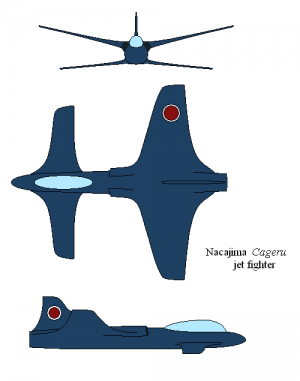Japanese Military Aircraft
Some of the aircraft used by the Japanese Military:
Jet fighters
Taçu

The Miçubixi Taçu ("Dragon") was the first jet fighter to enter service with the Japanese military. It began its service as a propeller-driven aeroplane, but the first production run of the fighter were not yet in service when the Scandinavian Realm and Dalmatia virtually simultaneously unveiled their first jet fighters, the Dragen and Spretu fighters.
Japanese military engineers quickly realised the potential of the new engine concept, and set about designing their own version. By 2003, they had a workable prototype, designed to be installed into the Taçu fighter with minimal changes necessary. This jet-engined version of the Taçu was named the Taçu-cai. Following flight tests, the new upgraded Taçu-cais began to enter service the following year.
By 2006, all of the existing propeller Taçus were upgraded to Taçu-cai, at which point the -cai designation was dropped by all but aviation purists and design engineers.
The Taçu is able to carry a substantial weapons load, and is currently in service in Japan with the Imperial Japanese Army Air Service as a fighter and ground-attack aeroplane. It is also used by the air forces of Alyaska, Beihanguo and Ezo as a fighter.
- Specifications:
- Crew: 1
- Length: 34' 3"
- Wingspan: 37' 4"
- Height: 9' 8"
- Max. takeoff weight: 11,032 lb
- Powerplant: 1 "Quicca J2" turbojet developing 3,100 lb force.
- Max. speed: 497mph
- Service ceiling: 39,400'
- Range: 450mi
- Weapons load: 1x 20mm cannon
- 4x 13.2mm espingols
- Pod for additional 8x 13.2mm espingols
- Wing racks for up to 10 short-range rockets or 2 small bombs
Cageru
The Cageru ("Dragonfly") fighter from Nacajima Industries is a newer design than the Taçu. It was designed from the first as a jet fighter, and entered service with the Imperial Japanese Naval Air Service in 2007.
The Cageru has a slightly unusual tandem wing design, which gives it several advantages (especially for a carrier-borne aeroplane, as most of the IJNAS' planes are). Most notably, the tandem wing design allows for a shorter wingspan to give the same wing area, allowing more planes to be carries without introducing the structural weaknesses and complexity of folding wing structures. The twin wings also allow a substantially larger area for control surfaces, and make the aeroplane inherently more stable.
The Cageru uses the same Quicca J2 engine of the Taçu, but is a slightly lighter plane overall, giving it a marginally greater operational range and maximum speed. Like the Taçu, it carries a heavy weapons load, though not quite as heavy as the other Japanese jet.
- Specifications:
- Crew: 1
- Length: 32' 2"
- Wingspan: 28' 10"
- Height: 8' 10"
- Max. takeoff weight: 10,620 lb
- Powerplant: 1 "Quicca J2" turbojet developing 3,100 lb force.
- Max. speed: 512mph
- Service ceiling: 39,400'
- Range: 460mi
- Weapons load: 2x 20mm cannon
- 2x 13.2mm espingols
- Wing racks for up to 8 medium rockets, 2 small bombs or 1 antishipping torpedo
